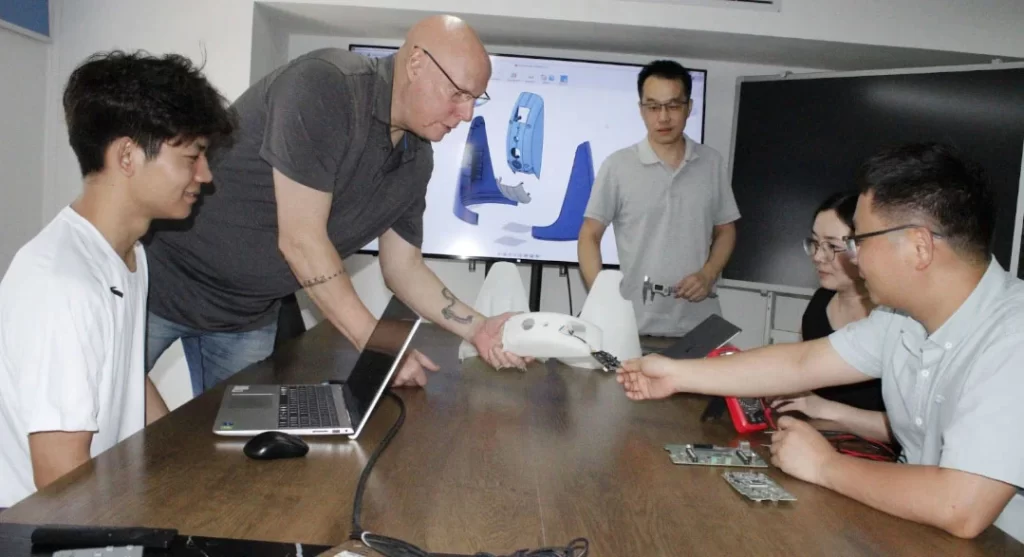Talk To Us About Your Needs
Getting from a working prototype to mass production is sometimes a complex and tough journey. We help you plan ahead and we take the right steps in the right order.
What you need is:
- Ensuring that you have a good product design.
- Developing the right processes for manufacturing and testing your product.
What we do
We may work on numerous possible tasks. Each project is different, so we tailor it to your needs and budget. Our project plan may include the following tasks:
Product design review, improvement & validation
We focus on making the product design better and easier to manufacture toward the end of the product design phase.
Depending on the project, we may work on:
- Design reviews for part manufacturing, for assembly, for quality, for reliability…
- Safety and reliability risk assessments
- Refinement of material/component selection
- Initial tooling (before cutting metal) to validate what can realistically be achieved
- Building prototypes for testing & validation, and to evaluate ease & speed of assembly
- Accelerated reliability testing; reliability validation
- Compliance testing and management of related certifications
- Bridge production run to deliver devices to early customers and to collect their feedback
Note: if you need us to take care of some of the engineering work, or the industrial design, please let us know. We can probably help.


Manufacturing & process development & validation
We reduce the risks of quality defects, project delays, and unexpectedly high costs, and overall we speed up your time to market by following our structured New Product Introduction (NPI) process, and typically includes most of the following:
- Planning for a roadmap to production that makes sense for your project
- Risk analyses (pFMEA, etc.) and control plan where needed
- Development of quality checklists, testing stations, etc.
- Fabrication of tooling and it validation
- Setting up lines and equipment, and confirming readiness for manufacturing
- Pilot runs (PVT)
- Ramp up of production volumes (MP)
- Corrective actions and continuous improvement
- Ongoing reliability testing
- And other actions as appropriate
What are the benefits of working with us on ensuring your product is designed for manufacturing?
First, if your product has not been designed for manufacturing, it might simply not be possible to make it in high volume. Some people have come to us, for instance, with a plastic enclosure that can be 3D printed but not injection molded.
Second, depending on the project, a few adjustments to the product design can yield several of the following benefits:
- Catching design issues by doing a design review, thereby avoid time-consuming rework down the road
- Lower cost by using more off-the-shelf parts, by picking different materials, by making assembly much faster, etc.
- Higher capacity and higher speed by making manufacturing easier & faster.
- Better quality by removing some sources of potential issues (e.g. in machining, surface treatments, assembly, …)
- Better reliability by addressing a weakness, by adding redundancy, etc.
- Better safety by removing certain hazards, designing in a better safeguard, making a catastrophic failure less likely through better reliability, etc.
You tell us what your objectives are, and we will work on addressing them!
What are the benefits of working with us to industrialize your product?
When it comes to certain products, developing the manufacturing and testing processes can be very complex. Our team has experience with many materials, processes, and technologies, and has worked across many product categories. We are not afraid of challenging situations.
We follow a structured New Product Introduction (NPI) process. It is a proven process that experienced manufacturers follow carefully. The project needs to go through pre-defined validations before it goes into the next phase. For example, making sure the product design is validated before cutting steel for tooling, if at all possible. That prevents the very common situation where the project needs to go back to the previous phase for time-consuming rework.
On the other hand, our customers often request exemptions and accept the related risks. In the end, it depends on the project size and on the safety hazards that might arise. A relatively simple and harmless product that does not call for tricky manufacturing processes can be brought into production relatively quickly and effortlessly.
We have seen many factories in China skip the small production runs (pilot runs) for new products. Unfortunately, despite all the efforts at evaluating & mitigating risks “on paper”, some issues will come up when a new product starts to be manufactured. Those issues need to be contained so bad products are not shipped to customers, and any serious issues need to be addressed before large quantities are released on the shop floor.
When does this work occur during the NPI process?
The tasks outlined will typically be happening between the end of phase 3 (Prototyping), phase 4 (Tooling), phase 5 (Pre-Production), and phase 6 (the first batches of mass production):




